Page 81 of 504
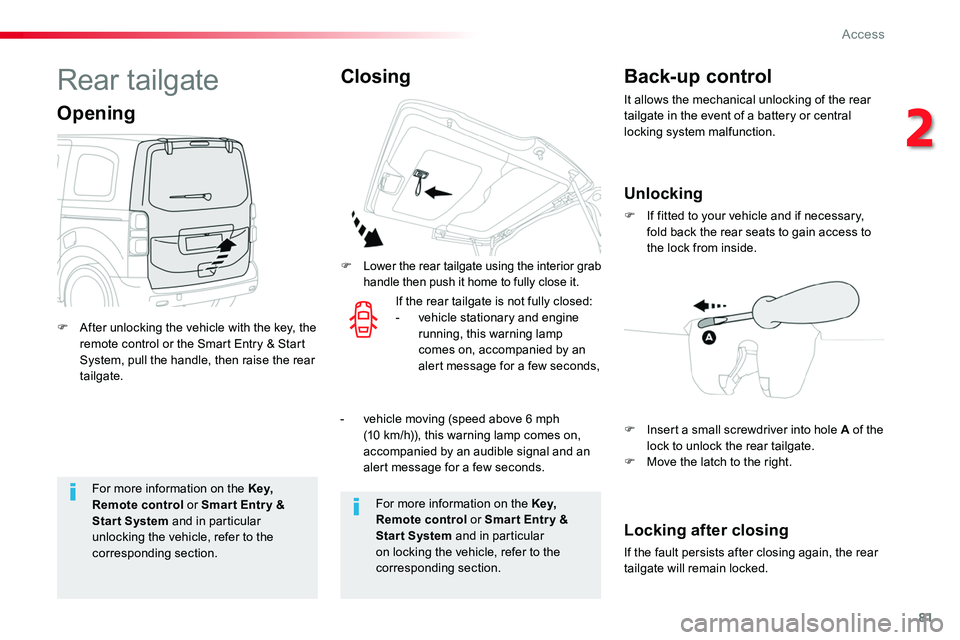
81
For more information on the Key, Remote control or Smar t Entr y & Start System and in particular unlocking the vehicle, refer to the corresponding section.
For more information on the Key, Remote control or Smar t Entr y & Start System and in particular on locking the vehicle, refer to the corresponding section.
Rear tailgate
F After unlocking the vehicle with the key, the remote control or the Smart Entry & Start System, pull the handle, then raise the rear tailgate.
Opening
F Lower the rear tailgate using the interior grab handle then push it home to fully close it.
ClosingBack-up control
It allows the mechanical unlocking of the rear tailgate in the event of a battery or central locking system malfunction.
Unlocking
F If fitted to your vehicle and if necessary, fold back the rear seats to gain access to the lock from inside.
Locking after closing
If the fault persists after closing again, the rear tailgate will remain locked.
If the rear tailgate is not fully closed:- vehicle stationary and engine running, this warning lamp comes on, accompanied by an alert message for a few seconds,
F Insert a small screwdriver into hole A of the lock to unlock the rear tailgate.F Move the latch to the right.
- vehicle moving (speed above 6 mph
(10 km/h)), this warning lamp comes on, accompanied by an audible signal and an alert message for a few seconds.
2
Access
Page 82 of 504
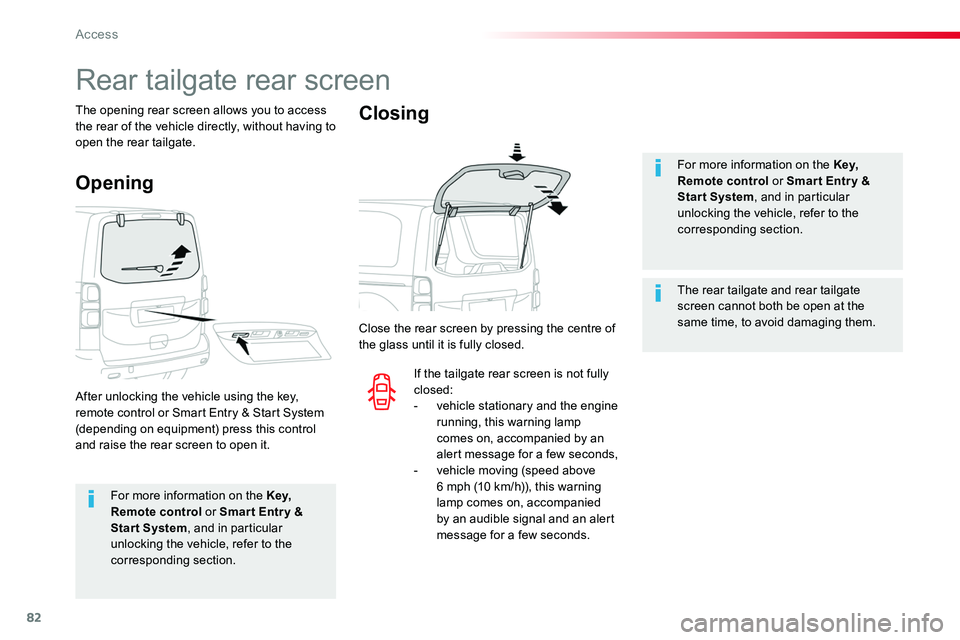
82
For more information on the Key, Remote control or Smar t Entr y & Start System, and in particular
unlocking the vehicle, refer to the corresponding section.
For more information on the Key, Remote control or Smar t Entr y & Start System, and in particular unlocking the vehicle, refer to the
corresponding section.
The rear tailgate and rear tailgate screen cannot both be open at the same time, to avoid damaging them.
Rear tailgate rear screen
The opening rear screen allows you to access the rear of the vehicle directly, without having to open the rear tailgate.
Opening
Closing
After unlocking the vehicle using the key, remote control or Smart Entry & Start System (depending on equipment) press this control and raise the rear screen to open it.
Close the rear screen by pressing the centre of the glass until it is fully closed.
If the tailgate rear screen is not fully closed:- vehicle stationary and the engine running, this warning lamp
comes on, accompanied by an alert message for a few seconds,- vehicle moving (speed above 6 mph (10 km/h)), this warning lamp comes on, accompanied by an audible signal and an alert message for a few seconds.
Access
Page 83 of 504
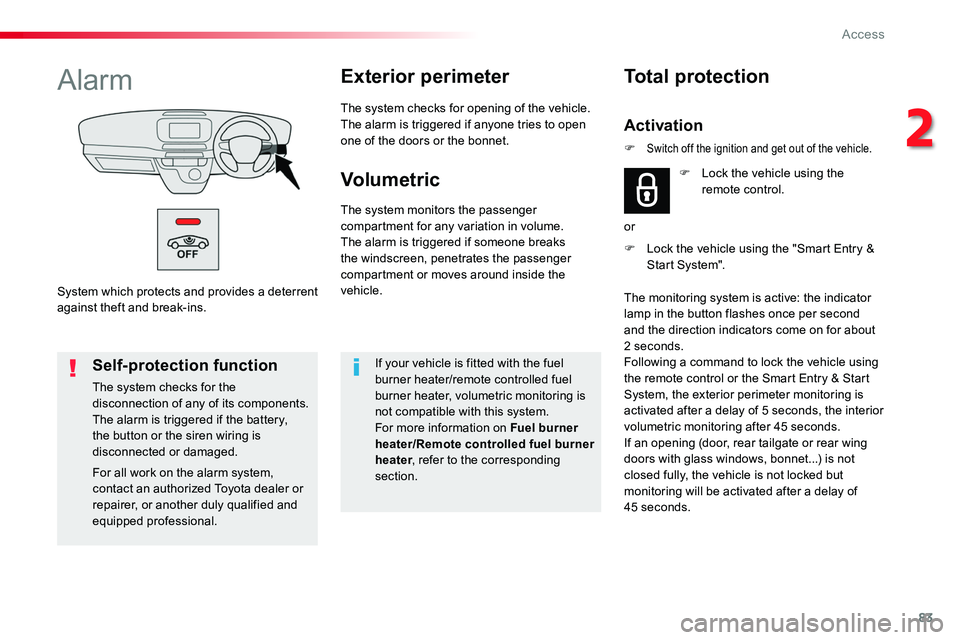
83
System which protects and provides a deterrent against theft and break-ins.
AlarmExterior perimeter
The system checks for opening of the vehicle.The alarm is triggered if anyone tries to open one of the doors or the bonnet.
Self-protection function
The system checks for the disconnection of any of its components.The alarm is triggered if the battery, the button or the siren wiring is disconnected or damaged.
For all work on the alarm system, contact an authorized Toyota dealer or repairer, or another duly qualified and equipped professional.
Volumetric
The system monitors the passenger compartment for any variation in volume.The alarm is triggered if someone breaks the windscreen, penetrates the passenger compartment or moves around inside the vehicle.
If your vehicle is fitted with the fuel burner heater/remote controlled fuel burner heater, volumetric monitoring is not compatible with this system.For more information on Fuel burner heater/Remote controlled fuel burner heater, refer to the corresponding section.
F Lock the vehicle using the "Smart Entry & Start System".
Total protection
Activation
F Lock the vehicle using the remote control.
or
The monitoring system is active: the indicator lamp in the button flashes once per second and the direction indicators come on for about 2 seconds.Following a command to lock the vehicle using the remote control or the Smart Entry & Start System, the exterior perimeter monitoring is activated after a delay of 5 seconds, the interior volumetric monitoring after 45 seconds.If an opening (door, rear tailgate or rear wing doors with glass windows, bonnet...) is not closed fully, the vehicle is not locked but monitoring will be activated after a delay of 45 seconds.
F Switch off the ignition and get out of the vehicle.
2
Access
Page 84 of 504
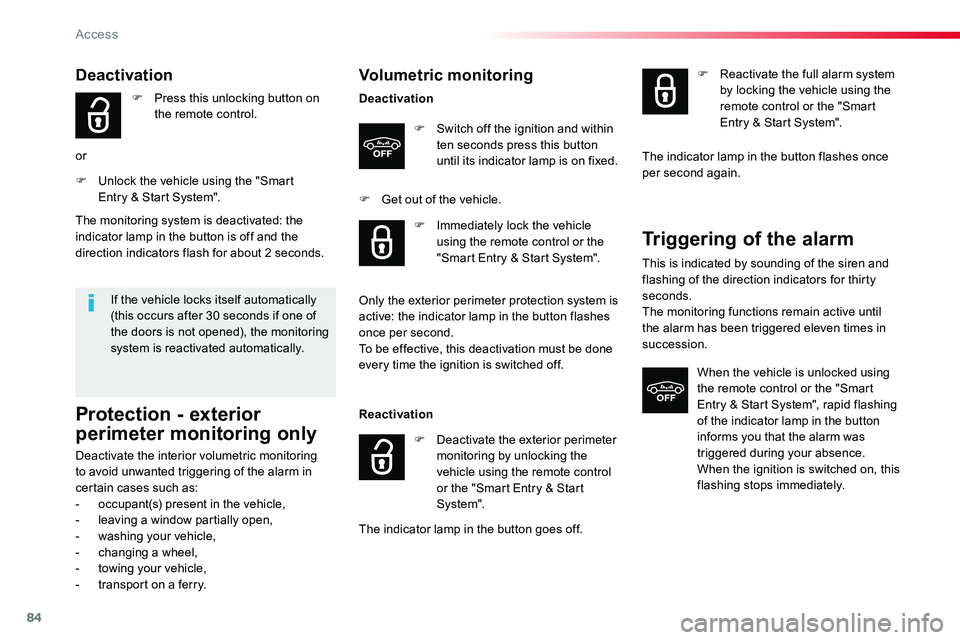
84
Volumetric monitoring
Deactivation
F Switch off the ignition and within ten seconds press this button until its indicator lamp is on fixed.
F Get out of the vehicle.
Reactivation
The indicator lamp in the button goes off.
F Immediately lock the vehicle using the remote control or the "Smart Entry & Start System".
Only the exterior perimeter protection system is active: the indicator lamp in the button flashes once per second.To be effective, this deactivation must be done every time the ignition is switched off.
F Deactivate the exterior perimeter monitoring by unlocking the vehicle using the remote control or the "Smart Entry & Start System".
F Reactivate the full alarm system by locking the vehicle using the remote control or the "Smart Entry & Start System".
The indicator lamp in the button flashes once per second again.
Triggering of the alarm
This is indicated by sounding of the siren and flashing of the direction indicators for thirty seconds.The monitoring functions remain active until the alarm has been triggered eleven times in succession.
When the vehicle is unlocked using the remote control or the "Smart Entry & Start System", rapid flashing of the indicator lamp in the button informs you that the alarm was triggered during your absence.When the ignition is switched on, this flashing stops immediately.
Deactivation
F Press this unlocking button on the remote control.
or
F Unlock the vehicle using the "Smart Entry & Start System".
If the vehicle locks itself automatically (this occurs after 30 seconds if one of the doors is not opened), the monitoring system is reactivated automatically.
The monitoring system is deactivated: the indicator lamp in the button is off and the direction indicators flash for about 2 seconds.
Protection - exterior
perimeter monitoring only
Deactivate the interior volumetric monitoring to avoid unwanted triggering of the alarm in certain cases such as:- occupant(s) present in the vehicle,- leaving a window partially open,- washing your vehicle,- changing a wheel,- towing your vehicle,- transport on a ferry.
Access
Page 85 of 504
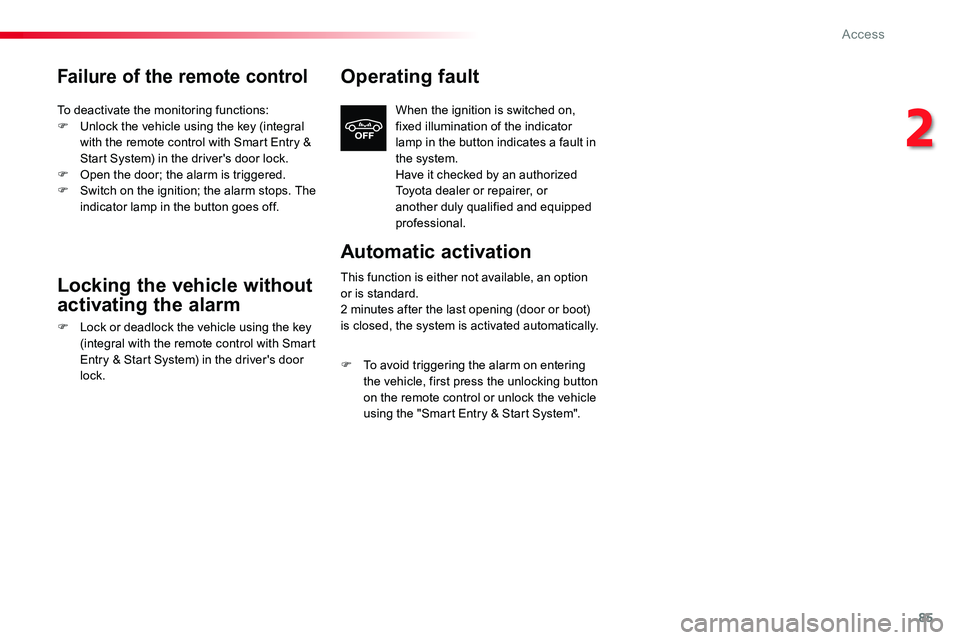
85
Failure of the remote control
To deactivate the monitoring functions:F Unlock the vehicle using the key (integral with the remote control with Smart Entry & Start System) in the driver's door lock.F Open the door; the alarm is triggered.F Switch on the ignition; the alarm stops. The indicator lamp in the button goes off.
Locking the vehicle without
activating the alarm
F Lock or deadlock the vehicle using the key (integral with the remote control with Smart Entry & Start System) in the driver's door lock.
Operating fault
When the ignition is switched on, fixed illumination of the indicator lamp in the button indicates a fault in the system.Have it checked by an authorized Toyota dealer or repairer, or another duly qualified and equipped professional.
Automatic activation
This function is either not available, an option or is standard.2 minutes after the last opening (door or boot) is closed, the system is activated automatically.
F To avoid triggering the alarm on entering the vehicle, first press the unlocking button on the remote control or unlock the vehicle using the "Smart Entry & Start System".
2
Access
Page 87 of 504
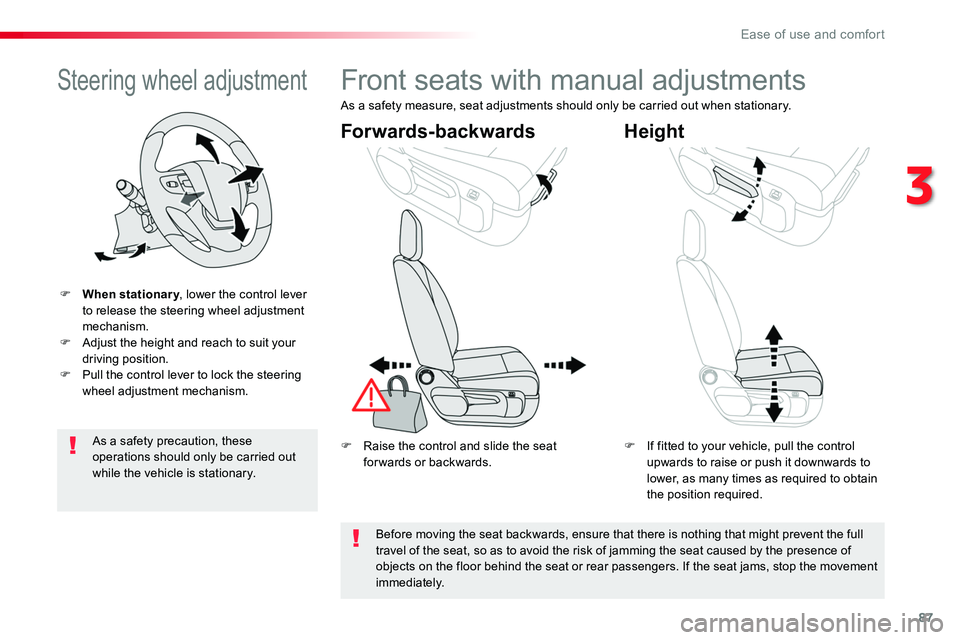
87
Steering wheel adjustment
F When stationary, lower the control lever to release the steering wheel adjustment mechanism.F Adjust the height and reach to suit your driving position.F Pull the control lever to lock the steering wheel adjustment mechanism.
As a safety precaution, these operations should only be carried out while the vehicle is stationary.
Front seats with manual adjustments
F Raise the control and slide the seat for wards or backwards.F If fitted to your vehicle, pull the control upwards to raise or push it downwards to lower, as many times as required to obtain the position required.
Forwards-backwardsHeight
As a safety measure, seat adjustments should only be carried out when stationary.
Before moving the seat backwards, ensure that there is nothing that might prevent the full travel of the seat, so as to avoid the risk of jamming the seat caused by the presence of objects on the floor behind the seat or rear passengers. If the seat jams, stop the movement immediately.
3
Ease of use and comfort
Page 96 of 504
96
F If your vehicle has the facility, place the seat backrest in the table position.
Tipping, access to row 3Removing a seat
F If your vehicle has the facility, place the backrest in the table position.F Tip the seat for ward.
F Using the handle, release the rear feet then tip the seat for ward.F To return the seat, tip the bench towards the rear until the feet lock into place.
It is not necessary to fold the backrest (table position) to tip the bench seat for access to row 3.
F Release the front feet using these handles.F Disengage the seat from its anchorages.F Remove the seat.
If removing and storing a bench seat out of the vehicle, ensure that it is placed in a clean area, so as to avoid introducing any foreign bodies into the mechanisms.
The bench seats are not designed for any use other than in the vehicle. They have mechanisms and functions that could be damaged if used incorrectly or are dropped.
Ease of use and comfort
Page 97 of 504
97
Ensure that no object, or the feet of a passenger seated at the rear, could obstruct the anchorage points or prevent the correct latching of the assembly.F If your vehicle has the facility, pull the control and raise the backrest (from the rear, lower the lever).
Check that the seat has correctly engaged in its anchorages on the floor when returned to the seating position.
Refitting a seat
F Engage the front feet in the anchorages in the floor (as shown above).
F Check that there is nothing obstructing the anchorages or which would prevent the correct engagement of the feet.
F Lock the front feet using the handles.F Tip the seat toward the rear until the rear feet lock into place.
Be aware of the feet of any passengers while tipping the seat.
3
Ease of use and comfort